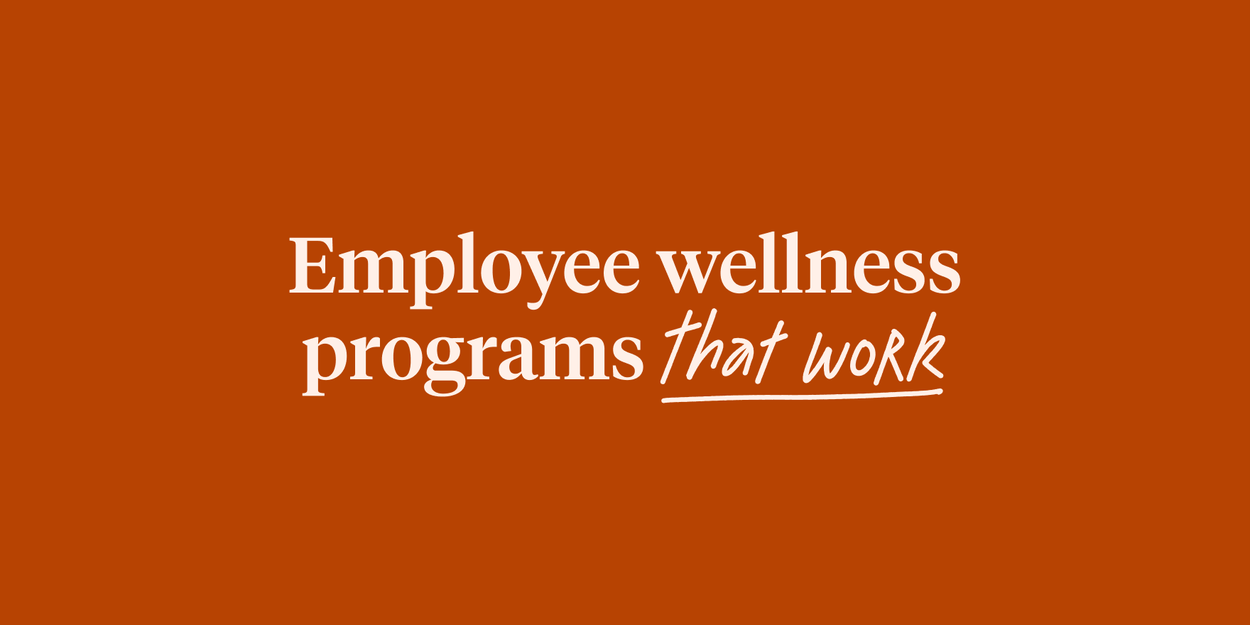
Written by

Director of Demand Generation, Nextiva
You’ve heard of employee wellness programs. Your company may even have one. These programs focus on the physical health of your employees by offering gym memberships, smoking cessation incentives, better snack choices, and other ways to get your team healthier.
The idea here is two-fold and (pretty old school). First, keeping employees healthy means they don’t miss work as often. And second, healthy employees result in lower healthcare costs which equals lower insurance premiums.
But more and more, companies realize there’s more to wellness than just their employees' physical health. Sure, it's important your team is healthy and at work, but ensuring they're productive and engaged is the goal. Financial strain, child care concerns, and other "life" problems can weigh heavily on your employees – and keep them from being their best when working with you.
Instead of looking at insurance premiums and the bottom line, companies are now focused on their employees' overall wellbeing because it's the right thing to do. Plus, happy, engaged employees help make for a successful business.
Take a look at these employee wellness programs to boost your employees' wellbeing, engagement, and job satisfaction.
1. Flexible working hours

Startups and other young companies have already figured this one out. It's the older and bigger companies that have yet to climb on board. If your employee's role doesn't depend on a specific range of hours in the day, why are you forcing them to work those hours?
Let's face it, many positions aren't beholden to the old 40-hour workweek standard anymore. And if your employees are dealing with kids, sharing a vehicle, or scheduling college courses, there's a good chance that schedule is a pain in their necks.
Relieve some of your team's daily stress and focus on employee wellness by allowing flexible working hours when appropriate. Permitting an employee to shift their schedule by as little as one hour could make all the difference. You can even consider offering the choice of a four-day workweek. Which is the more productive employee – one rushing to work in a frazzled mess or arriving calm and ready to get down to business?
Who's doing it right:
Defense contractor and cybersecurity company Raytheon recognized their employees were becoming increasingly concerned with work-life balance. In an effort to ease the burden, they instituted a flexible working schedule with several options, including what they term the "modified workweek." The modified workweek allows Raytheon employees to work the days and hours that best fit their schedules, providing they work a total of 80 hours each bi-weekly pay period.
2. Remote working arrangements
Along with flexible working hours, why not offer your team the opportunity to work remotely? While it's not the right fit for every situation (or for every employee), most organizations have at least some roles that can be handled remotely, making this a great option for an employee wellness program. Plus, the COVID-19 pandemic has proven that remote work, well, works.
It's been statistically proven that employees who can work from home – even if only occasionally – are happier. Consider how many call-ins you have during flu season (or worse yet, people who come to work sick.) If you're in an area with inclement weather, how often does it keep people from work? These are both common scenarios that cause stress to your employees and are a burden to your business. Allowing remote working is an easy solution.
Moreover, one of the key reasons people left their companies during the Great Resignation was the lack of flexibility towards work-from-home arrangements. A survey conducted by FlexJobs reported that 58% of participants agreed they would "absolutely" look for a new job if they couldn't continue remote work in their current role.
Who's doing it right:
Health insurance titan, Anthem, learned early on – employees who are chained to a desk are probably not performing their best. Anthem has a long-standing remote work program encompassing most of its offices across the country. In fact, many positions at Anthem have been relegated to full-time remote status. Others can work from home one or more days per week.
Anthem has found their remote work program attracts – and retains – the best people and consistent, quality work.
3. Financial education

Stressing about money happens to everyone at some point. Financial stress is a burden that can affect every area of life, including your job. If you have an employee consumed with money woes, there's a good chance they're not engaged at work and certainly don't have time to focus on wellness.
Providing financial education to your employees can help alleviate this strain while teaching them a key life skill - and your employees will appreciate it. This goes beyond the 401K person who comes to the office once a year. Your employees can benefit from learning how to budget, how investing works, and how to best plan for retirement.
Remember, your company is likely made up of people in all stages of life, from 20-somethings right out of college to seasoned staff nearing retirement. Tailor your financial education offerings and your employee wellness programs accordingly.
Who's doing it right:
The US-based east-coast supermarket chain, Wegmans, knows employee wellbeing isn't limited to physical health. Their robust employee assistance program offers, among other benefits, help planning for dependent and elder care costs and long-term and short-term financial planning.
Along with educating their team on financial literacy and planning, Wegmans offers an unheard-of 6% 401k match.
4. Give your employees autonomy
Nothing kills employee engagement and employee morale like a lack of autonomy. But when your team members can make decisions and take action in their roles, they'll be more invested in their success and that of your company. This translates to happier employees and happier people.
For your next employee wellness program, train your staff in the art of critical thinking and then give them decision-making power. Make "taking the next step" an initiative and a goal to achieve. When your employees find success flexing their decision-making muscles at work, they'll soon put those same muscles to work in their personal life.
Not only will your staff be happier and more engaged, but you'll also notice more successful customer interactions and better overall customer service.
Who's doing it right:
The worldwide luxury hotel chain, Ritz-Carlton, has taken employee empowerment to the next level. With an eye on customer satisfaction, Ritz-Carlton team members are authorized to spend up to $2,000 per guest to resolve customer issues. There's no need to speak to a supervisor or get approval from a manager.
While this goes a long way to make customers happy, it also gives employees a feeling of empowerment. This trust and flexibility help team members feel more invested in their jobs, which leads to better performance.
5. Require work-life balance
Dedicated employees are an asset to your company. But be careful encouraging your team – even indirectly – to skip lunch, forgo vacations, or make a habit of coming in early and staying late. Employees with little to no work-life balance are traditionally among your team's unhappiest and least engaged members.
Instead, make work-life balance a priority in your business for employee wellness. Some companies even require their staff to take time off. Be sure your employees know you value their lives outside the office - and they should, too.
Implement cross-learning and backup coverage to make your employees feel comfortable and happy about taking time away from work.
Who's doing it right:
App developer, FullContact, is serious about balance in their employees' lives. Their unlimited vacation policy encourages team members to take time off when needed, with no hard feelings. In fact, FullContact is so dedicated to fostering a balanced environment that employees are offered a $7,500 annual bonus for taking time away from the office. If the employee checks email or voicemail while away, the bonus is taken off the table.
6. Celebrate employee's successes
Meeting company goals, whether big or small, should be a cause for celebration. When your team works toward a common goal but sees little to no acknowledgment once it is met, their engagement naturally turns downward. Worse still, they may not be as motivated when the next task or project rolls around.
Show your employees you care and appreciate their hard work through this employee wellness program. This can be done with trips, local outings, in-office parties, even a simple shout-out in the monthly newsletter.
Don't forget to share your team's successes outside your company, too. If you're proud of your team, let everyone know about it with a press release, a write-up in a trade publication, or a video.
Who's doing it right:
IT giant, Cisco, knows celebrating success is important. Each team at Cisco is allotted a "fun fund." This money is earmarked for parties, and other activates to celebrate goals achieved, successful projects, and other positive milestones.
Knowing there's some fun time at the end of a challenging project helps with motivation. But more importantly, Cisco's fun funds let employees know their hard work is appreciated.
7. On-site fitness accommodations

Just because the focus has moved to your team's overall wellbeing doesn't mean you can't offer programs specific to their physical health.
In the past, companies often focused on employee wellness programs by securing discounts at local health clubs, and encouraging employees to attend outside work hours. This program is only nominally successful because most people who would've taken advantage already had a gym membership.
Instead, invest in an on-site fitness center. And don't stop there – Incentivize your employees to work out by allowing them an hour to do so during work hours. Your employees will have the opportunity to not only work out with their friends and colleagues, but they can do it without driving out of their way before or after work.
Who's doing it right:
Finish Line, the well-known athletic apparel retailer, isn't missing out on the obvious cue – They're giving many of their team members a place to put their sneakers to work. Many Finish Line warehouses and corporate offices offer an onsite gym, some even complete with a basketball court. Employees who might not otherwise work out or visit a gym now make use of the onsite facilities. Finish Line knows healthier workers are happier workers.
8. Add collaborative workspaces
Collaborative workspaces can help your team's engagement and wellness in several ways.
The mere act of working in close physical proximity to others is proven to foster engagement and creativity. Allow your team the opportunity to move out of their cubicles or offices and work in a shared space where talking and collaborating are easier.
Providing your staff with a break from their everyday surroundings is like a breath of fresh air. It encourages a different kind of thinking and fosters new ideas. And getting to know co-workers is a bonus.
But remember, not every employee is cut out to work in a collaborative space. Some may have trouble staying focused, while others may feel it's intrusive. Allowing your team the option to work collaboratively is perhaps a better option than forcing them to do so.
Who's doing it right:
International banking pillar, Citibank, has recently started using collaborative workspaces in several of their larger international offices. And they're not the only ones. Other large companies like Google allow their team members to work in a collaborative space, particularly when working on projects or other shared tasks.
9. Support community involvement
You may not think encouraging your employees to spend time outside the office promotes engagement or wellness. But fostering an environment of community involvement can transform your company culture. Volunteering makes people feel good. When your employees have a chance to work for a cause they care about, you'll have a happier, more well-rounded team.
Take your cues from others within your organization who already volunteer. They can help you champion this employee wellness program. Learn about the various organizations in your area and work with them to set up a volunteer opportunity for your team.
If planning a company-wide volunteer program isn't your speed, you can still encourage community involvement. Allow your employees a few hours a month to spend time away from the office participating in the volunteer program of their choice.
Who's doing it right:
Timberland, the outdoor apparel retailer, has been supporting community involvement since 1992. Timberland pays employees for days off – up to 40 hours per year – for volunteering. This volunteering time-off program is separate from any other personal or vacation time.
An attitude of giving started in Timberland's corporate offices back in the '90s and is now an integral part of their company DNA, from top to bottom.
10. Parent coaching and support

Parenting is hard. Working parents face unique challenges, especially in the digital age, where work follows you everywhere you go. This is an employee wellness program every company should offer.
Help your staff work toward a better work-life balance while also improving the relationship with their family by offering parent coaching. Employees with a happy home life are naturally more engaged and motivated while on the job.
You can also consider starting an employee resource group for working parents. At Culture Amp, we have an ERG called Camp Carebears, which is an ERG aimed at empowering employees with caregiving responsibilities so they can be sustainably successful
Who's doing it right:
Etsy's online marketplace launched its new, comprehensive parent support program in 2016. As part of this program, parents are given access to coaching, counseling, and other outlets for support. Working parents often struggle more than their childless counterparts, and Etsy's corporate team wanted to address those struggles positively.
11. De-stressing activities
Reduce employee stress and boost engagement by offering classes in yoga, meditation, tai chi, or similar relaxation techniques.
While you may not intentionally stress your employees out, there are surely times their job causes tension and stress. Show your employees you recognize the stressful times and are willing to help out by prioritizing mindfulness in the workplace.
Employees who can deal with stress effectively are proven to be among the best team members. Set your staff up for success by helping them learn to relax and manage tension.
Who's doing it right:
Wegmans makes our list again with its on-site health and wellness screenings and customized yoga plans available to all team members. Stressed-out workers are not the best employees, and Wegmans decided to tackle the problem head-on. Their customized yoga programs give team members the tools and techniques to relax, decompress, and even get healthier.






